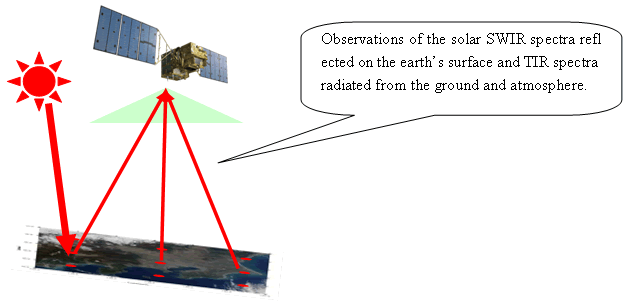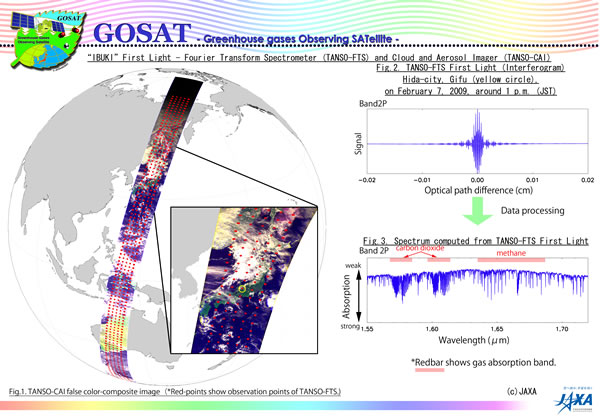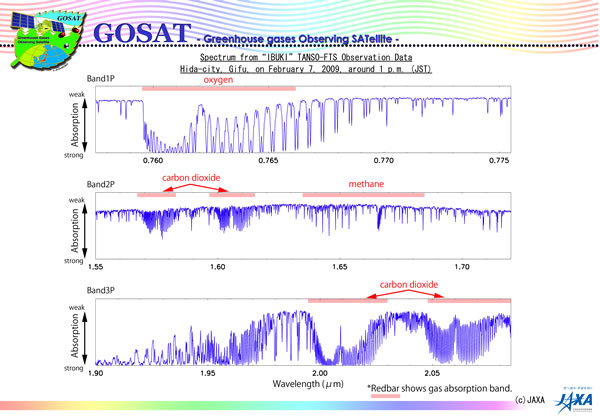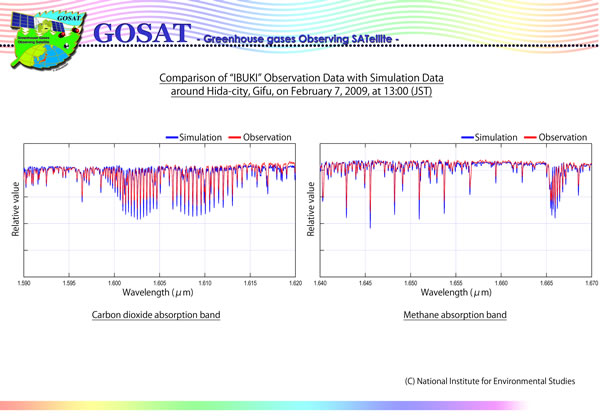Measurements matter in global climate affairs. "IBUKI" is the Greenhouse gases Observing SATellite (GOSAT) that has been circling the Earth since January 23, 2009.
IBUKI ('breath' in Japanese) will assist in precise monitoring of the global atmospheric carbon dioxide concentrations when its observation data sent from space are combined with data obtained on land and used with simulation models. Methane is also observed.
Onboard Instruments
GOSAT carries two instruments which are the main and auxiliary sensors. Thermal And Near infrared Sensor for carbon Observation Fourier-Transform Spectrometer (TANSO-FTS) is the main sensor while the TANSO Cloud and Aerosol Imager (TANSO-CAI) is the auxiliary one.
The TANSO-FTS has about 18,500 spectral channels to cover a wide spectral range from short wave infrared (SWIR) to thermal infrared (TIR).
The TANSO-FTS has about 18,500 spectral channels to cover a wide spectral range from short wave infrared (SWIR) to thermal infrared (TIR).

FIGURE A. The GOSAT Observation.

FIGURE B. Radiance spectra and images are obtained by TANSO-FTS and TANSO-CAI, respectively. The observation points of the TANSO-FTS are overlaid on the false color composite image by TANSO-CAI in Fig. 1. The First Light (Interferogram) taken by the TANSO-FTS is shown in Fig. 2. The First Light data were used for the spectrum given in Fig.3. Note the redbar for carbon dioxide and methane. (Credit: JAXA)
Initial Activities
FIGURE C. TANSO-FTS acquired on February 7, 2009 these spectra for Bands 1, 2, and 3. Band 4 was not taken then. (Credit: JAXA)
These graphs show the intensity of each wavelength of Band 1, 2 and 3 individually. Band 1-3 has p- and s-polarized spectrum. With increasing greenhouse gas concentration, absorption gets stronger and light intensity bocomes weaker.
FIGURE D. IBUKI data confirm simulation data by the National Institute of Environmental Studies (NIES), a partner organization for GOSAT. Note the positions of the absorption lines of the observation data match those of the simulations. (Credit: JAXA and NIES)
Status
IBUKI works as designed. The spectroscopic performance of the TANSO-FTS was found to be as designed. Calibration and validation activities are ongoing to confirm data accuracy and the characteristics of the instruments. Some data products were released to users, after completion of the initial calibration activities. No validated global data maps will be available until next year.
GOSAT also recorded the Total Eclipse of 2009 on July 22. (See the five Earth images with Japanese titles in Galileo and The Photogenic Total Eclipse of 2009.)








Comments